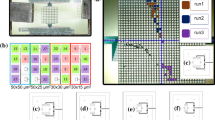Abstract
High spectral resolution detectors based on low-resistivity transition-edge sensors (TES) are being developed for future X-ray spatial observatories, but difficulties (cryogenics limitations) are to be expected in next generation’s detectors with even more pixels. A new technology, the high-resistivity TES (HRTES), is likely to offer similar performance to existing TES when associated to an active electrothermal feedback, adding the possibility of moving the readout electronics to a 2.5 K stage of the cryocooler. This work aims to investigate HRTES by making a precise model of the device, comparing it to experimental measurements, and deducing its performance potential.



Similar content being viewed by others
Notes
In particular, Fig. 2a, b shows that the variation of the thermometer resistance Rt according to the silicon bulk temperature Tb (increasing with the heating bias) and the bias current (proportional to Vpol, because Rpol ≫ Rt) is reproduced relatively accurately by simulation thanks to the electrons–phonons decoupling included in the model, without having to introduce a direct dependence between Rt and the bias current, as the βI term (see for example Bennett et al. [11] or Smith et al. [12]. This would tend to mean that, so far measurements indicate, this term is likely small and therefore a negligible contribution, especially in detection configuration where, once the bias point selected, the current through the thermometer always remains almost constant, as Rpol≫ Rr. Nevertheless, this will be investigated in more detail in the future (evaluation of the possible impact on noise).
References
D. Barret et al., The Athena X-ray Integral Field Unit (X-IFU), in Proceedings of SPIE 10699, Space Telescopes and Instrumentation 2018: Ultraviolet to Gamma Ray, 106991R (2018). https://doi.org/10.1117/12.2314450
C. Nones et al., High-impedance NbSi TES sensors for studying the cosmic microwave background radiation. A&A 548, A17 (2012). https://doi.org/10.1051/0004-6361/201218834
G. Jego et al., High impedance TES with classical readout electronics: a new scheme toward large x-ray matrices, in Proceedings of SPIE 10699, Space Telescopes and Instrumentation 2018: Ultraviolet to Gamma Ray, 106995T (2018). https://doi.org/10.1117/12.2315624
M. Galeazzi, D. McCammon, Microcalorimeter and bolometer model. J. Appl. Phys. 93, 4856 (2003). https://doi.org/10.1063/1.1559000
S. Marnieros, C. Nones, L. Dumoulin et al., Electron–phonon decoupling NbSi CMB bolometers. J. Low Temp. Phys. (2012). https://doi.org/10.1007/s10909-012-0532-8
S. Marnieros, L. Bergé, A. Julliard et al., Low temperature specific heat of NbSi Anderson insulator measured by cryogenic bolometry. Phys. B 259, 862–863 (1999)
P.M. Downey, A.D. Jeffries, S.S. Meyer et al., Monolithic silicon bolometers. Appl. Opt. 23(6), 910–914 (1984)
V.Y. Bodryakov, A.N. Bashkatov et al., Heat capacity of tantalum in the normal superconduction states: identification of the contributions. Russ. Metall. 9, 671–675 (2013)
J. Mather, Appl. Opt. 21(6), 1125–1129 (1982)
M. Galeazzi, J. Appl. Phys. 93(2), 4856 (2003)
D.A. Bennett et al., A two-fluid model for the transition shape in transition-edge sensors. J. Low Temp. Phys. 167, 102–107 (2012). https://doi.org/10.1007/s10909-011-0431-4
S.J. Smith et al., Characterizing the superconducting-to-normal transition in Mo/Au transition-edge sensor bilayers. J. Low Temp. Phys. 151, 195–200 (2008). https://doi.org/10.1007/s10909-007-9619-z)
Acknowledgements
We thank our funding partners: Labex P2IO and CEA Saclay.
Author information
Authors and Affiliations
Corresponding author
Additional information
Publisher's Note
Springer Nature remains neutral with regard to jurisdictional claims in published maps and institutional affiliations.
Electronic supplementary material
Below is the link to the electronic supplementary material.
Rights and permissions
About this article
Cite this article
Jego, G., de la Broïse, X., Sauvageot, JL. et al. High-Resistivity Transition-Edge Sensor Modeling and Expected Performances. J Low Temp Phys 199, 88–94 (2020). https://doi.org/10.1007/s10909-020-02426-1
Received:
Accepted:
Published:
Issue Date:
DOI: https://doi.org/10.1007/s10909-020-02426-1




